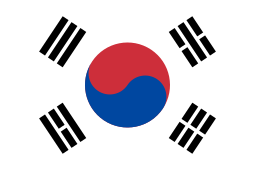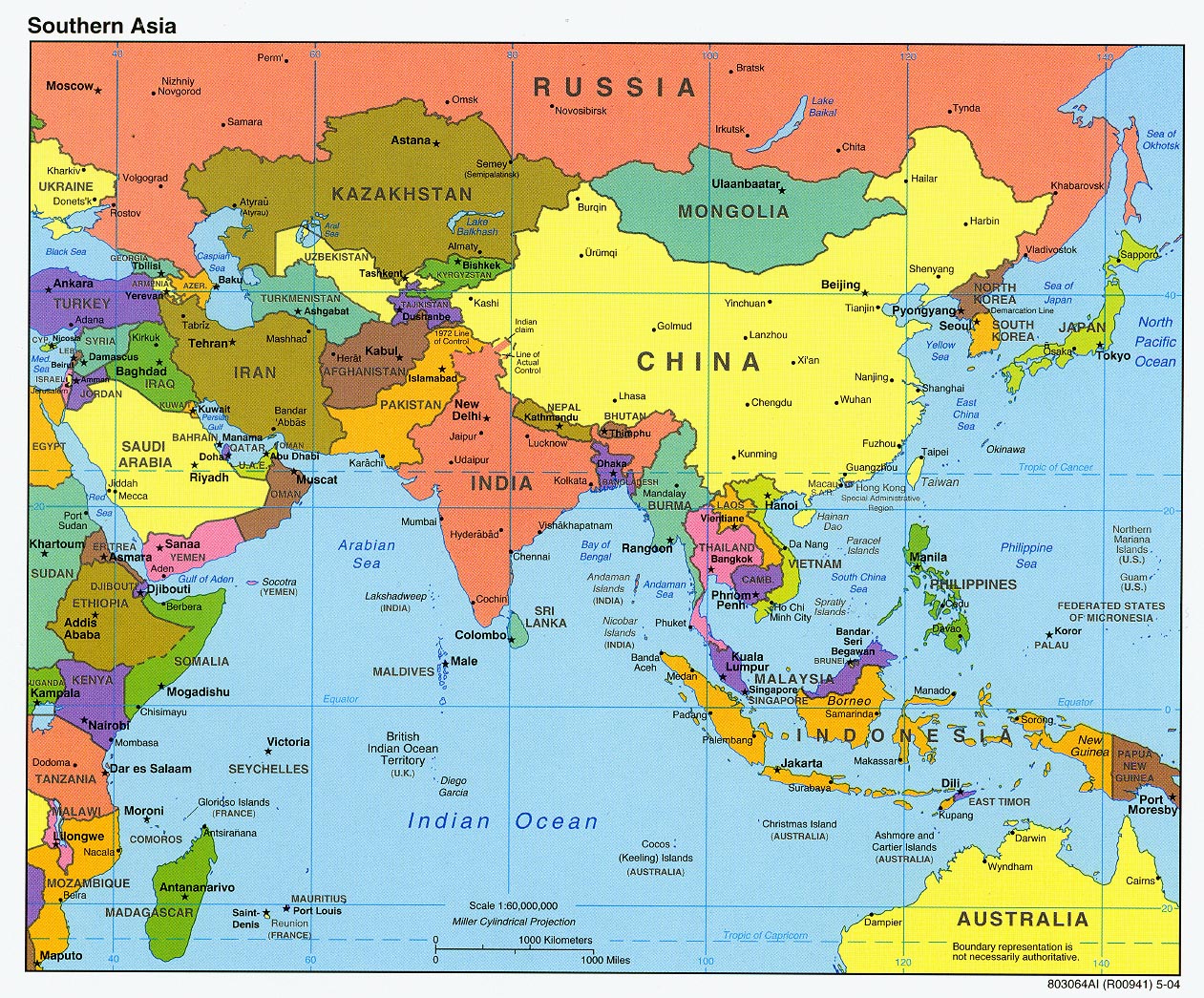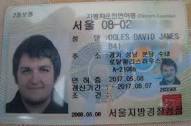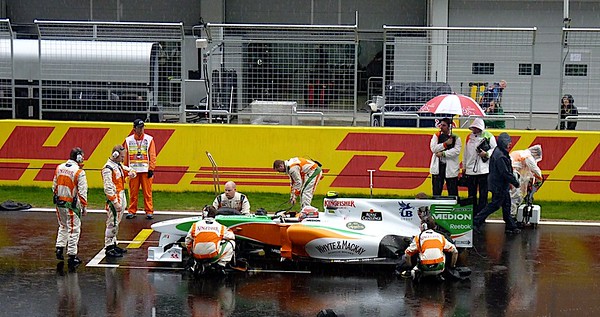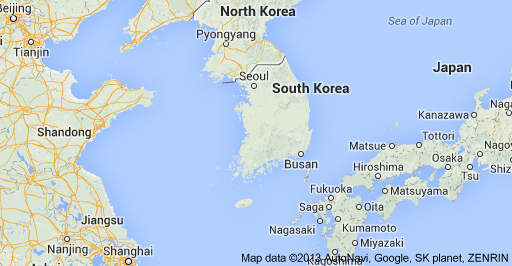Greetings from Yeongam, Jeollanam-Do, South Korea
From the travels and adventures of the “World’s #1 Trackchaser”
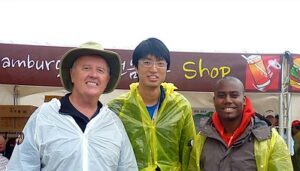
Korea International Circuit
Trackchasing Country #48
Lifetime Track #1,605
Editor’s note #1
To avoid any confusion it should be noted that I returned to Los Angeles for just two days after traveling last week all over Europe and specifically to Romania and Bulgaria before I left again for South Korea.
Greetings from the United States
Editor’s note #2
Everything written in the “Advance Preparation” section of this Trackchaser Report was reported before I ever landed in South Korea. In order for a trip like this to be successful a good deal of advance preparation must be done. That planning takes place at the world headquarters of RLR – Randy Lewis Racing in San Clemente, California. However, the planning for this trip began just 24 hours before I left the house!
Trackchasing in South Korea will increase my lead in the all-important most countries seen category to 48-46 over Belgium trackchaser Roland Vanden Eynde. That means he must see THREE MORE countries in order to take the lead. Recall that various worldwide “bylaws and treaties” call for the trackchaser who first reaches a number to be the winner of all ties.
Like to know more about South Korea?
If you’d like to learn a little more about South Korea the country, check out the “background” information I prepared for you. It appears at the bottom of this report. I have condensed this section so you can get a good “feel” for this Asian continent location.
TODAY’S HEADLINES
This race was billed on the Formula One website as being in Seoul, South Korea. It wasn’t! …………..details in “Surprise!”.
Should I rent a car in South Korea?…………….more in “The feedback I was receiving worried me”.
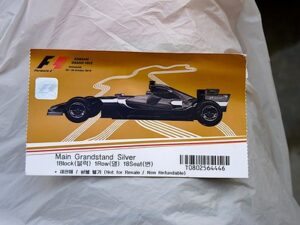
The cost of a Formula One race ticket was shocking …………..details in “Are you kidding me?”.
This was the most critical part of the trip. …………..details in “Please, please, answer the phone.”.

The ticket I wanted would cost $800. I didn’t have $800……………more in “I still needed a ticket”.
I’ve had a lot of good international dining experiences….this wasn’t one of them. …………..details in “I felt as is I knew ‘Uncle Vern’”.
ADVANCE PREPARATION
Why South Korea?
I would like to tell you I’ve been planning to trackchase in South Korea for months. However, that would not be true. You might be surprised how I actually did end up here.
Typically there is a good deal of “Advance Preparation” that goes into one of these trips. Several “items” need to be checked off. First and most important to get the trip started was to confirm there would be a race. Once that’s done there’s the transportation, hotel, rental car and …….of course, the “companion selection” process. There are lots of other things that need to be covered too. When this was finished it would be time to “get out of the house and head on down the road”.
Editor’s note #3. You might wonder why I take the time to provide so many details about the logistical and economic portion of the trip. It’s simple. I hope that when people read one of my reports they can see themselves making an adventure like this. I’ll explain how I organize things as well as what it takes money-wise to make it happen. Then maybe that “spark” will come to a reader…..and before they know it they will be touching down in a Malta or an Iceland or an Australia or somewhere far from their home…..and somewhere far from their comfort zone.

Secret international agents rule!
I still maintain the very best “secret international agents” available to any trackchaser. They reside all over the world. It’s just that none of them has much expertise in a place like where I would be visiting. That place was South Korea.
One more Asian continent country?
If successful, South Korea will be my seventh Asian continent trackchasing country. The current list looks like this:
Bahrain
China
Japan
Qatar
Thailand
United Arab Emirates
I hope you don’t plan your trips this way.
How does one end up in Seoul, South Korea when the plan was to go to Peoria, Illinois? This question and many others will be answered in the course of today’s dialog. I recommend you put yourself in my shoes during the time you read this. What would you have done? What would your “strategic thinking” direction have been?
Secrecy promotes the capitalistic approach in trackchasing.
For several weeks I had been planning a trip to a “secret” track in Illinois. No other trackchaser knew about this track. My plan was to fly out to the Midwest, visit family, play some golf, see this mysterious track and then tell all of my fellow competitors how they could visit this track sometime in the future.
However, about ten days before my planned departure to Peoria my iPhone weather channel app was predicting a rainy Saturday for October 23. Often times these “advance forecasts” change for the better as I get nearer to the date. However, this forecast actually changed for the worse. The rain forecast went from 40% to 70%, the day before the event. Even the next day, which was planned for golf, called for a 60% chance of rain. Only a forecast like this could get me to change my plan.
I didn’t want to fly into a storm.
Two days before my Illinois trip, with the advance weather forecast looking bad, I began to think about a foreign adventure as a replacement. Yes, there’s a good reason I rarely get rained out along the trackchasing trail. Granted I had just returned a day or two ago from Romania and Bulgaria among other faraway places. However, for international trips, I always have my bags packed.
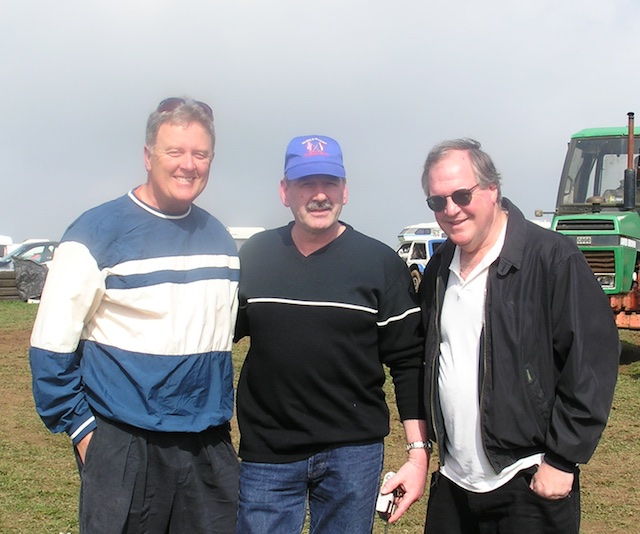
Randy, Colin Herridge, P.J. Hollebrand
I’m blaming this one on the Englishman.
South Korean did not come on my radar screen until 24 hours before it was time to leave. Englishman, Colin Herridge (above center) sent me some information about the racing plans for Formula One in South Korea. I didn’t give this faraway Asian nation any serious thought at the time. I had ANOTHER Asian country lined up if the weather stayed bad in Illinois.
Just for kicks could I even get to South Korea?
A day before I was scheduled to leave for this OTHER (obviously unnamed for trackchasing security reasons) country, I thought I would check flight availability to South Korea just for fun. This would be the first-ever Formula One visit to this country. That made the trip even more intriguing.
I was shocked, amazed and happy at the same time to see that I COULD make it to Seoul, South Korea with just two flights. I could connect in San Francisco and then fly non-stop to Seoul.
The devil is in the details.
When I’ve traveled to other Asian countries (Thailand, Japan, China) where the road signs are indecipherable I have opted for public transportation including taxis, buses and trains. The South Korea race had been billed as “being in Seoul” or so I thought. Once I got serious about going to South Korea I began an extensive search to confirm several unknown details.
Surprise!
I discovered a shocker! I had planned to take a taxi around Seoul and hopefully to the racetrack. My shock was in learning that the racetrack was some 400 kilometers (250 miles) from the South Korea capital of Seoul. This shed an entirely different light on this project.
I would be landing in Seoul at the Incheon International Airport at 3:30 p.m. on Saturday afternoon. The race was set to begin at 3 p.m. on Sunday afternoon. I would plan to return to the U.S. (flights permitting) on Monday. This would give me plenty of time for a big college fraternity golfing shindig in Las Vegas beginning the Thursday after my return.
Should I rent a car in Asia?
I would have 24 hours to get to the track once I landed. Seoul is 16 hours ahead of sunny San Clemente time. That meant I would be landing in Seoul at midnight my time. I figured the only way to pull this trip off was to rent a car. In the U.S. traveling 250 miles given the above limitations would be no problem at all. In South Korea, it might be a different story.
Folks, the United States is very different from many of the countries I visit. It is ESPECIALLY different from an American’s point of view. Nevertheless, I would rent a car. I figured a GPS system would save the day for me in South Korea like it has so many times in my country.
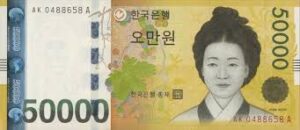
I reserved a compact car with Hertz for a two-day price of $123. By the way, the currency of South Korea is the won. One U.S. dollar would buy about 1,125 won. My rental car would cost about 177,000 won. I didn’t know if that many won would fit in my money clip!
This was not good news.
The Hertz agent gave me some information I didn’t want to hear. First, she told me that a GPS system had to be reserved 48 hours in advance. I didn’t meet that requirement. Secondly, she told me I needed an “International Driving Permit”. I didn’t have one of those either. No, planning these trips is NEVER easy.
I figured I would “override” the system as I am wont to do by calling the Hertz location in Seoul, South Korea directly. Of course, when I came up with that idea it was 4 a.m. in Seoul. When the time situation improved I gave them a call using my iPhone “TruPhone” app. The call quality was crystal clear, the phone rang immediately and it cost me less than five cents per minute. TruPhone truly does rock.
Of course, I got someone who barely spoke English. That didn’t surprise me, but it was frustrating. From what I could understand the GPS units they offered were only in “Korean language”. I know. You can program your GPS here at home to speak several different languages. Apparently, that’s not how they do it in South Korea!
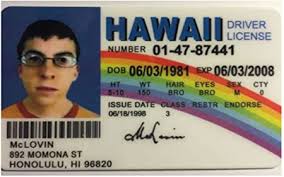
My Hawaii driver’s license wouldn’t do me much good here.
Wait! The concerned reader might be heard to exclaim, “The headline says you have a Hawaii driver’s license. You live in California. What’s up with that?” Folks this is the best thing I can tell you. Some questions just cannot be answered without me asking for a top-secret security clearance from you. Sorry.
It sounded as if I would need an “International Driving Permit”. The permit is good in more than 50 countries. I had purchased one of these previously, from AAA, for South America when I traveled to Chile. Of course, THAT permit was only good for South American countries.
I debated whether or not I needed such a permit. They had never asked for it when I went to Chile. However, if renting a car was my only option to get to the track this weekend and they DID require an “International Driving Permit” and I didn’t have one I was screwed. It would be no fun taking an 11-hour flight to South Korea and being stranded at the airport 250 miles from the track.
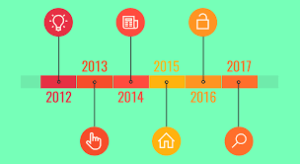
Please track with me on the timeline of events from here. If you do and can put yourself in my position, I think you will have a much more fun read. At 4:45 p.m. on Thursday afternoon, I flew, via the Carol Lewis owned and Life of Virginia sponsored Lexus LS430, into the San Clemente AAA parking lot. They were closing at 5 p.m. Soon I was walking out of the office with my own personal “International Driving Permit” complete with my picture. My pocket was $23 lighter but if that is what it takes to remain competitive in the “Total Countries Seen” arms race then so be it.
The feedback I was receiving worried me.
Nevertheless, I will tell you I was worried. Without GPS and road signs in a foreign language (South Korean) that doesn’t use English letters, I had a problem. I went to TripAdvisor.com and asked for some assistance. I asked my friends over there what they thought of my driving in South Korea. Here are some of the tips I received:
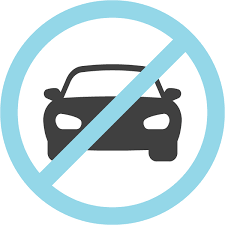
1) Korean drivers tend to not use signals.
2) If you give the signal to make a lane change, don’t expect drivers to let you in.
3) Korean drivers have just about the worst tempers in the world. Don’t get in a fight with one.
4) If you get in an accident, even if it’s just a scratch, Koreans (especially taxi and truck drivers) will grab their neck and pretend they are hurt. It’s just best to give them whatever cash you have and let them go.
5) A car’s emergency lights usually mean “I’m sorry” (for cutting in) or “I’m stopping” (in front of this store).
6) Korean police will often turn a blind eye to traffic violations, especially when traffic is heavy.
7) About 90% of Korean drivers are crazy!
Oh, my. I had no idea if all of this or just some of it were true. Carol would not be coming along on this short three days/two-night trip. She had a previously scheduled babysitting gig. Plus, once we get to this time of year, she doesn’t travel well until the Christmas rush has passed. I was on my own. Yes, I was worried.
I was departing the Orange County airport at 6:45 a.m. on Friday morning. All Thursday night I searched and searched the internet for clues. How could I make this trip work better? By the way, I fully understand that no matter how much I plan things much of the plan will not come off when traveling in a foreign country.
Waegook Cook Travel to the rescue.
Just as I was about to give up I came across an English speaking travel group that was organizing lodging and transportation for the Formula 1 race in South Korea. The outfit was called “Waegook Cook” Travel. This sounded perfect. However, I was “so last minute” that I feared they couldn’t help me. Their website, http://f1.waegookcook.com/ offered several phone numbers. I called them all, via TruPhone, and none of them answered. Now I was really frustrated and worried even more. Later I would learn everyone was at the Formula 1 practice day.
Just as I was going to bed on Thursday night, I decided to send an email to the address listed on the website. I explained my situation. Then I went to bed at 11 p.m. My alarm was set for 4:36 a.m. on Friday morning. I woke up a few minutes in advance of that (from worry!) and walked next door into my office. My email had been answered overnight. It was Waegook Cook’s owner, Derrick Smith responding. Derrick gave me a phone number to call.
‘David’ would save the trip!
This might be the most important paragraph of this entire adventure.
With no time to waste and my flight leaving in less than three hours, I made the call to South Korea. It was nearly 5 a.m. my time but 9 p.m. THEIR time. A Korean woman answered, in English. I explained my situation. She immediately put “David” on the phone. David was a full English speaking American who was “from all over but mainly Washington, D.C.”. He was both empathetic and helpful with regard to my travel situation. David would save the day, and the trip, for me.
Just so you know if I had not gotten the go-ahead from David I would not have gone on this trip. This international trip was so tenuous that just three hours before my flight was to depart I didn’t know for certain if I was going to South Korea or not.
Would you have done this?
David recommended I take the bus from the Seoul airport to Gwangju, South Korea (This is Gwangju, South Korea). Gwangju is the fifth biggest city in Korea with about 1.5 million people. It would be a 4-hour bus ride from Seoul to Gwangju after dark. Gwangju is about an hour from the Korean International Circuit. To some, this might not have sounded like a good idea. Considering the alternative was driving under some tough conditions, sitting on a bus sounded like a GREAT IDEA to me.
This put me at ease. At least I wouldn’t be driving in South Korea. Now I would “simply” fly up to San Francisco and catch an 11-hour flight to South Korea. Then I would navigate myself to a bus at the airport, ride it for four hours through the Korean darkness in hopes of ending up in the right city. Then I would try to talk a non-English speaking cab driver into calling the one and only working phone number I had in all of Korea. If all of THAT worked, I would be driven over to a motel where, hopefully, David would have a room for me. Then the next morning I would go on the tour bus to the track and see racing in my 48th different country.
I knew that when I landed in South Korea and took the bus to Gwangju I had just one local piece of information with me. It was a single phone number. I had ZERO idea where the hotel was. I didn’t have the name of the hotel. I did not have ANY other information at all. If I had miscopied the phone number I was screwed. If no one answered at the number when I called I would be screwed. The more I thought about it, the more I thought I was screwed!
Trust until…..the simple approach.
If you have not guessed by now I am a trusting soul. Of course, when someone breaks that trust, they are out with me for the rest of time. I find it simpler to operate that way.
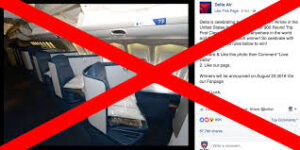
Some day it would be time to come home.
Once in San Francisco it dawned on me that I didn’t have any return airline tickets. Wait! Do you ever fly to places like South Korea without any return tickets? No, I didn’t think so. My focus had been on getting to South Korea. But sooner rather than later I would want to get back home right?
How would I pay for everything on this trip?
I was carrying about $600 U.S. and another $300 in Euros. For a guy that never carries more than $100 cash that seemed like a lot of money. Of course, I had three credit cards at the ready as well. Nevertheless, when I saw the opportunity to “change some money” I did so.
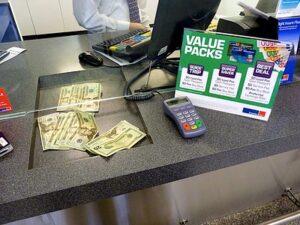
Money exchanges in airports are convenient. However, in the travel business “convenience” normally means “expensive”. The money changer in the San Francisco airport gave me about 16% less money than the wholesale exchange rate. I probably would have done better using my ATM card once I got to South Korea.

Are you kidding me?
David, my contact in South Korea, had mentioned that Korea is a “cash economy”. I hope I can get by with the $900 I have. He also gave me some disturbing news about race tickets. Yes, they could be bought at the track. However, according to him, the LEAST expensive ticket would run around $300!!
I have never paid $300 for a race ticket in my life. I can’t recall ever paying more than $100 U.S. David went on to say that many of the tickets in the best locations were being sold for more than $2,000. Wow!
Formula One has never rocked my boat.
I am not a Formula One fan. Since so many people are (primarily folks living outside the U.S.) I must be missing something. Heck, I don’t like soccer either. In most countries outside the U.S., soccer is the #1 most popular sport. All of those people can’t be wrong, right? Nevertheless, even if everybody in the world loves spinach I still don’t care for it.
I’m sure this event will be a spectacle. However, I can already envision having a seat where the cars pass my position in 5-10 seconds and then roar out of sight for the next two minutes. This is not my first rodeo. We’ll see how it goes but I am not expecting much from this race.
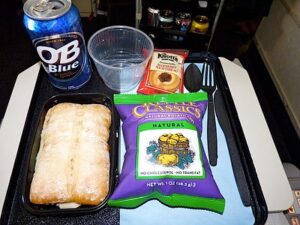
I made the best out of a coach class seat.
Once onboard the plane I learned I would be sitting in coach. More times than not, on these overseas flights, I am upgraded to business class. Luckily, I was randomly given an exit row seat. It’s one of those seats where the row in front is nearly six feet away. Therefore, I had all the legroom in the world. My computer had a battery life of 6-8 hours. My Bose headset keeps out lots of unwanted noise and filters in the sound it does allow. I had to enjoy the remaining time I had where I controlled things. In just a few short hours, I wouldn’t be controlling much. I just hoped I could find the right bus and then meet the right people that let me seem some racing in South Korea. That is the primary and really sole purpose of this trip. Anything else is secondary.
Here are a few other MAIN details that I had to consider with this plan.
THE RACE
There must be a race.
Sometimes I worry about whether I will travel such a long way and the race won’t come off. Knock on wood that has never happened in a new country foreign visit. You wouldn’t think that a group with the stature of “World Formula One” would be a problem in this regard.
However, this is the first year F1 has ever raced in South Korea. The track is brand new. Due to construction problems, they didn’t get the final approval on this race until just two weeks ago. I’ll breathe a sigh of relief AFTER the green flag drops.
Not only was the race threatened with cancellation by rain but there were other problems. This note comes from Wikipedia about both political and track construction concerns.
Following increased hostilities between North Korea and South Korea in the wake of the sinking of the South Korean corvette Cheonan in March 2010, Formula One Group chief executive Bernie Ecclestone said the race would be in jeopardy if political tensions continued to escalate, and it would be abandoned if the North Korean army crossed the border. The revival of the French Grand Prix at the Circuit de Nevers Magny-Cours was mooted as an alternative if the Korean Grand Prix was cancelled. Although hostilities between the two nations eventually relaxed, the race was further threatened by delayed construction. On 27 September 2010, Ecclestone said he doubted the circuit would be ready despite the laying of tarmac. A final inspection of the circuit took place on 11 October; Fédération Internationale de l’Automobile (FIA) safety delegate Charlie Whiting certified that the circuit was ready on 12 October. The top layer of the track was completed ten days before the race; there was not enough time for the elements to remove the oils and bitumen chemicals in the tarmac. Circuit designer Hermann Tilke said the surface would be slippery, making the race challenging for drivers and exciting for fans.
THE VISA
Just your passport, please.
That’s right. All I needed to do was show up with a valid U.S. passport and getting into South Korea would be easy. No visa required.
THE TRANSPORTATION
Orange County to San Francisco to Seoul. This sounded pretty straight forward to me.
Yes, the entire trip would be about 24 hours worth of flying. Not a problem. I was a “latch key” kid. I know how to entertain myself when I’m alone.
TIME ZONES
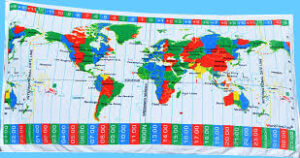
What time is it?
Last weekend Romania and Bulgaria were 10 hours ahead of Pacific time. South Korea will be 16 hours ahead of us. Heck, I think I’m still on European time! I’ll just deal with it. That always works pretty well.
CURRENCY
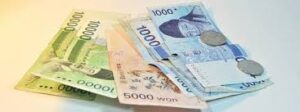
This might be a problem.
The official currency of South Korea is the won. The wholesale rate of exchange is 1,125 won to the dollar. I would prefer to use credit cards during this trip. However, I’m thinking that may be difficult to do.
WEATHER
I don’t care if it rains.
However, it’s not going to rain. Race day weather in Seoul calls for a high of 72 degrees Fahrenheit and a low of 50 under partly sunny skies. There’s only a 10% chance of rain. This sounds like San Clemente weather. Even if there was going to be rain, the Formula One boys race rain or shine. Having the pavement “tear up” is more of a concern than rain.
OVERNIGHT ACCOMMODATIONS
Since “She” is not on this trip the options are wide open.
“Trackchasing’s First Mother” (that would be wife, Carol) is not coming along on this trip. That means I can sleep on the floor of the airport or in my car if I need too. With the initial plan of renting a car, I fully considered sleeping in the car. The racetrack is said to be built in a very rural area of South Korea that doesn’t have much infrastructure.
Now I “think” I have a hotel room for the evening I land. I have no guarantees on that. I don’t have a hotel name much less a “booking”. All I have from a guy I’ve talked too on the phone one time is “when you land give us a call. You can take a taxi over to our place (at about 11 p.m.) and we’ll have a room for you.” There was no confirmation number, no nothing. I’ll soon find out how that works.
THE RENTAL CAR
I very much enjoy driving in foreign countries. I can stop when and where I like. However, I had been hopelessly lost in foreign countries as well. That’s no fun. In places where the road signs are not in English characters, I don’t mind having a chauffeur. Just to be safe, I didn’t cancel my rental car reservation in case the bus idea fell through. If it does I’m probably “history” with regards to successfully trackchasing in South Korea.
NAVIGATION
I’ll go with Greyhound’s bus jingle, “Leave the driving to us”. Hopefully that will work out.
THE TRAVELING COMPANION
I’m traveling “solo” on this trip. That’s O.K. I’ll meet new friends along the way.
THE SUMMARY
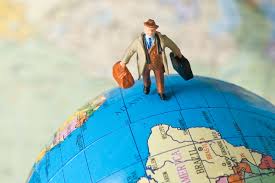
During the last ten months of 2010, my travel schedule has been daunting. I’ve made trips to Malta, Canada, Finland, Japan, Chile, Morocco, Brazil, Estonia, Latvia, Guatemala, El Salvador, Mexico, Romania and Bulgaria. Now I hope to add another exotic country to my list. Additionally, I’ve seen racing in 29 different U.S. states. Mind you, I’m “cutting back” this year!
However, there are still MORE countries to see. I plan on seeing them. I can’t tell you when (for security reasons) or where (again, for security reasons) but I will be adding new countries to my trackchasing list.
To be continued………………….
The Objective
Just do it.
I guess the objective of international trackchasing is simple. If there’s a race and I can get to it why not go. Life is short. I may not have the opportunity again.
The Trip
Day 2 – Saturday
Mission almost accomplished: I had made it to South Korea.
I landed in the Incheon International airport at 2:30 p.m. (10:30 p.m. – Friday, San Clemente time). This was an hour earlier than scheduled. The 11-hour flight seemed to go fast.
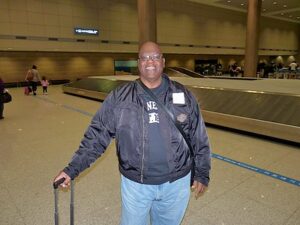
I walked with my new friend, “Skip” (above), who had been my seatmate for the past 11 hours, to the passport control area. Clearing customs took less than five minutes. About a year ago, I added 24 extra pages to my existing 48-page passport. I am now down to about 6-7 clear pages. All of the other pages are full of 4-8 stamps on each page!
Eleven hours on a plane, then five hours on a bus.
My Korean contact “David” had instructed me to buy a bus ticket at the airport for “Gwangju”. As soon as I walked out into the non-secure area of the airport I saw where they were selling bus tickets. There was very little English spoken but I soon understood the next bus to Gwangju was leaving in less than five minutes. I was happy to be able to pay the 30,900 Korean won (about $35 U.S.) ticket fee by credit card.
Incheon airport looked to be brand new. Later I found out it opened in 2001. Since I had to board the bus so quickly I didn’t have much chance to explore the airport. I’ll do that on the way back in less than 48 hours. This is such a short trip I will not have time to soak in much South Korean culture. Some trips are like that. It’s not my preferred way of doing things but sometimes that’s just the way “conflicting priorities” must be managed.
I was guessing the ride might take 4-5 hours. I didn’t really know. I was just hoping I was getting on the right bus going to the right place. For all I knew I had taken down the wrong destination name during my 4 a.m. phone call on Friday with my sole South Korean contact, David. If that was the case I might be heading toward NORTH Korea.
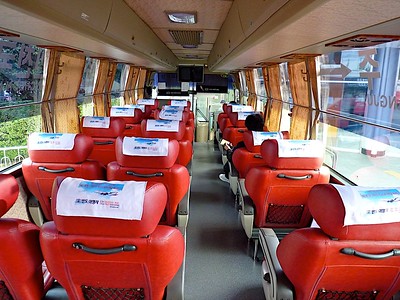
The bus was ultra-modern. It even included functional satellite TVs for passenger comfort. With sunset being at nearly 6 p.m. I would have plenty of time to see the sights, from the bus. Traffic was heavy and the roads were like our modern freeways. With the proper GPS direction, this would have been an easy drive. Without GPS probably still doable.
However, it was now midnight my time. The Korean International Circuit was 370 kilometers west of the airport. That’s pretty much a five-hour drive. It was probably best I was riding a bus. As I looked at the passing countryside there weren’t any hotels that popped out but I suspect they were hiding somewhere.
So much for personal creativity.

At one point I attempted to change sides of the bus from my front row position. This action was met with a stern rebuke from the driver in Korean. He motioned toward me. I was soon back in my original seat! My attitude in life is to ask for forgiveness rather than get permission.. I hadn’t gotten any approval OR permission from the bus driver.
We continued to drive on. It was dark now. At a little past 6 p.m., the driver took an exit. Were we there already? Nope! He was pulling over into a highway rest stop. This place was huge. There were some 50 or more passenger buses already stopped. The driver said something in Korean over the P.A. system. I’m sure he was telling everyone what time he or she had to be back on the bus. Of course, I had no idea what was being said.
This was my first Korean cultural experience.
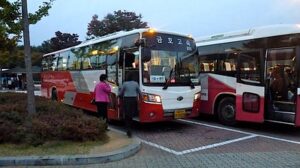
I tried to keep an eye on our bus as I took a walk around the rest stop plaza. There were several open-air food shops selling various local delicacies. At one point, I lost sight of our bus. That was disconcerting. All of the buses looked pretty much the same in my eyes. Finally, I noticed the bus with a digital readout of “15:20”. That was our bus. It was the bus that had departed the airport at 3:20 p.m. I could just imagine being left at this rest area without a ride any further!
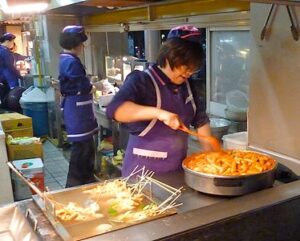
I still had no idea how much longer the ride would be. I had purchased a bottle of water (1,500 won) and a “chicken on a stick” (2,000 won) at the rest stop. I ate the chicken before re-boarding the bus. I smuggled the water back on the bus fully knowing that if the driver noticed I might be kicked off the bus.
Once we got back on the bus, the driver turned the TV system on. You’ve all seen those tear-jerker “infomercials” of a starving African boy who can apparently eat like a king if you just send along 49 cents a day. That was the type of show that was playing on our TV in Korean.
The next 15 minutes would make or break this trip.
The trip’s logistics were going very well. There was just one more item that needed to work perfectly. When the bus DID get to Gwangju, I had to have someone make a phone call for me. I needed the person I was calling, “David” to answer that call and give my taxi driver directions over to the hotel. If “David” didn’t answer I would likely be staring at my shoes in the Gwangju bus terminal trying to figure out what to do next. I didn’t like that option.
A bit more than four hours after we left the airport in Seoul, we arrived at the Gwangju bus terminal. The few passengers on the bus all knew to grab their luggage and fade into the night. My challenge was just beginning.
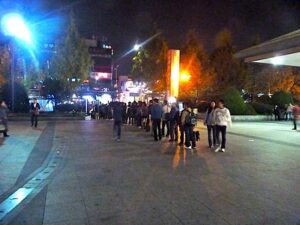
The bus terminal was adjacent to a huge shopping center. I nosed around there for a few moments. Then I ventured outside on a beautiful weather night with temps above 70. I stood in a long line to get a taxi. All I had was a single phone number. First, I would have to communicate with a Korean taxi driver that he needed to call that number before I would know where I was going. Secondly, someone had to answer my call.
Please! Please! Answer the phone.
I’m never shy about asking for help. While I was standing in line I asked two high-school-aged boys to tell the taxi driver he needed to make a call for me. The boys put down their game-playing cell phones. They were happy to oblige. My driver made the call, someone answered and off we went into the night. I thought everything was going well.
Welcome to Korea!
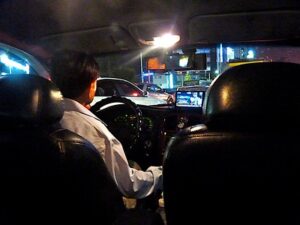
However, soon the driver turned down an alleyway. He was lost! Along came a young man on a small motorcycle. This was a restaurant deliveryman. My taxi driver stopped him to ask directions. There was a good deal of talk in Korean and then the young man made a call with his cell phone. Soon the directions were figured out. Then the young man looked at me and said in English, “Welcome to Korea!”.
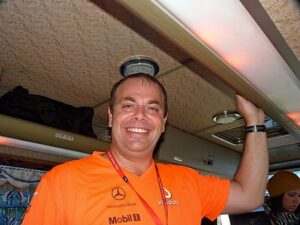
Derrick Smith would be a master host.
It wasn’t long before we were pulling up in front of the Lawrence Hotel. The neighborhood was a little off the beaten path but there were lots of blinking neon lights in every direction. The hotel staff didn’t speak any English but I gave them my “phone number”. Soon I was speaking with “Derrick”. He’s the ringleader for the Waegook Cook tour company.
Derrick was talking to me from his tour bus. It seems the tour group had run into a three-hour traffic jam and was just now getting back to the hotel after seeing today’s F1 practice. In just a few minutes, two buses with nearly 100 people offloaded. There were race fans from all over Europe in this group.
Things seemed a bit chaotic at this point. People were tugging at Derrick and his Korean-born wife, Sugi, regarding their room, where they were going to eat and lots of other things.
When the hubbub subsided I introduced myself to Derrick. I think he was just happy to have someone talking to him in a rational manner. I asked him what my options were.
There were still a few details to sort out.
There were several things to consider. First, I had to square away my hotel room. Then there was the matter of getting to the track tomorrow from Gwangju (about 70 km) and, of course, getting back from the track to my hotel tomorrow night. Oh ya, I still needed a race ticket as well. If you’re getting the impression I came here on a “wing and a prayer” you’re right!
Even though the bus to the races was “full” Derrick promised to find me a seat. He hooked me up with the Lawrence Hotel for both Saturday and Sunday night. Early on Monday morning, I would ride the same type of bus back to Seoul for my late Monday afternoon flight back to the U.S.
Meeting race fans from all over the world was a highlight.
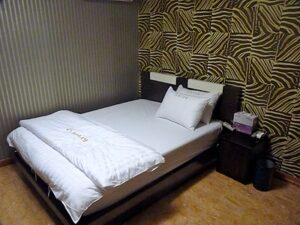
As I waited for my room I spent some time talking to several of the race fans. They seemed to think I could buy a ticket at the track tomorrow. They recommended several different grandstands where a good view would be available. Everyone was super friendly. Derrick, especially considering the pressure he was under from his customers, was very helpful and nice to me.
He invited me to join the huge group for dinner this evening. I probably should have. It would have been a good cultural thing. However, the local time was 10 p.m. (6 a.m. San Clemente time) and I had not slept, except for catnaps, in 26 hours. I begged off dinner, took a walk around the neighborhood and bought a snack or two from a convenience store across from the hotel.
I had taken a lot of chances today; the trip was still on track.
There are SO many things that could have gone wrong today. It seemed at every turn something that could have turned out badly turned out well. I still had not seen a race in South Korea. Heck, I didn’t even have a ticket to the race. But things were looking up. The group was leaving for the track tomorrow at 7 a.m. on Sunday morning. I would be there bright and early ready to go in search of racing in my 48th different country. This was going to be fun. That’s why I do these trips. It had already been a fun first day with lots of challenges. I absolutely love the “thrill of the chase” that comes with trips like this.
Day 3 – Sunday
Today is race day.
Yes, today is “race day”. This is trackchasing country #48 for me. It’s the first time I’ve ever seen a Formula One race outside the U.S. I’m excited to see what this event holds.
The bus to the track was leaving our hotel at 7 a.m. this morning. The weather forecast for Seoul, South Korea (200 miles to the north of the racetrack) had called for 72 degrees and just a 10% chance of rain. I came bopping down to the hotel lobby wearing just shorts and a t-shirt. That’s my garb nearly every day of my life in sunny San Clemente. However, my newfound friends from Scotland and the U.K. asked me if I had looked out the window this morning. I had not. If I had looked outside I would have seen it was raining and heavily overcast. Ouch! I was sent scurrying back to my room for more clothes.
This was a first for trackchasing.
I was excited about today’s racing. None of the “traditional” trackchasers had ever been to South Korea for racing. I wanted to be the first. That’s why I was among the first to line up for the bus. Derrick Smith, the trip organizer had told me last night that both buses were full. I might get a seat, but maybe not. As it turned out a few people missed the bus and I got a seat easily. By the way WHO missed the bus in a situation like this?
While waiting for last-minute stragglers I resumed my conversation with a few Europeans living in South Korea. I was surprised to meet so many young people (aged 20-35) who were working here under 1-2 year contracts, primarily as teachers. The guys from Scotland and the U.K. had all kinds of questions about my trackchasing. At first, people can’t believe I do this. Then after I share an example or two about some racing or activity in THEIR home area they soon come around.
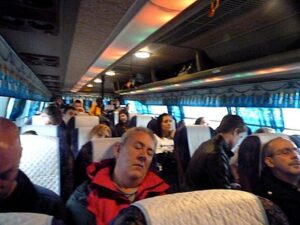
This was just a minor scare.
This morning’s bus ride would take us about two hours with traffic. Midway in the trip, our bus pulled over to the side of the road. We were having an “electrical” problem of some sort. The bus was on the newer side. We were stopped for ten minutes or so. I think the problem turned out to be a fuse. Maybe the guys just wanted a smoke break! I did give some thought that something as small as fuse could prevent me from seeing today’s race. I’ve learned never to count my chickens before they’re fried.

Today’s race was scheduled to begin at 3 p.m. We arrived in the parking lot of the Korea International Circuit at 9:30 a.m. That gave us plenty of time to “scout things out”.
Of the 100 or so race fans traveling on our two buses, I only met two other Americans. This was a couple that lived in Hawaii. Hawaii is not that far from South Korea.
I still needed a ticket for the race.
Everyone on the bus already had his or her race ticket. The folks I talked to were minorly amazed that I still didn’t have my race ticket. I tried to explain to them that was of very little concern to me. I told them this was how I normally operate. They looked at each other and seemed to say, “Good luck buddy. This is Formula 1. You’re going to wish you already had your race ticket”.
The Korea International Circuit is newly built. It’s been on the Formula One schedule for more than a year. However, the track was just “approved” by Formula One about ten days ago when final construction elements were completed. That’s cutting it close. KIC seats about 130,000 fans.
I figured it would be best to get a seat in the main grandstand. That way I could see the paddock area and the action on the starting grid. It was raining lightly now. I wasn’t worried about the race being rained out. Formula One always races rain or shine, right?
However, the rain was going to make my getting a ticket just a little more uncomfortable. I bought a plastic rain poncho for 5,000 won. The guy who was selling those “garbage bag” like plastic sheets was making a hefty (no pun intended as in Hefty trash bags) profit margin.
I wasn’t totally prepared for the ticket buying experience.
I had not thought to bring my “need one” ticket sign. That sign always works really well. I was just going with the traditional “index” finger raised toward the sky method of getting a ticket. Of course, in the states (yes, I know I wasn’t in the states) folks who want to buy a ticket simply walk around with X amount of fingers raised. Of course X = the number of tickets they are looking to purchase. My sign works better than fingers but all I had today was fingers!
Nevertheless, I wanted the best seat in the house.
Did you know that Formula One race tickets are VERY expensive? The main grandstand was divided into “Gold” and “Silver” section. The lower half of the grandstand seats was the Silver section and the upper half was gold.
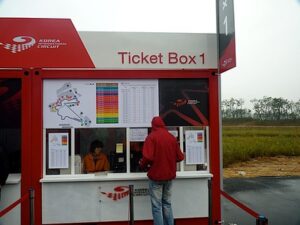
You’ve got to be kidding me!
The “ticket box” aka ticket booth was selling tickets. All tickets were priced in the South Korean “won” currency. Tickets in the “Gold” section were priced at 759,000 won. Folks, that’s $859 U.S.!! “Silver” tickets, in the lower half of the main grandstand were being sold at 709,500 won. That comes in right at $800 U.S. Wow!
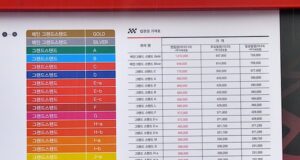
Did these Korean folks know that I didn’t have the trackchasing budgets of those big East coast trackchasing teams that I compete with every weekend? Did they know that I come from a sleepy little seaside village in San Clemente, California? Did they know all I can afford back home is a modest seaside cottage that doesn’t even have a yard? I travel on a small budget and just hope I have enough in my pocket to get back home……or something like that.
I had my work cut out for me.
I certainly had my work cut out for me. First, it was raining. Secondly, I was positioned near the grandstand entrance to the track only. That meant that a big portion of the crowd, who might have an extra ticket to unload, would not even be passing by me. However, there was an even bigger problem that I would face.

I estimate that 95% or more of the people who walked past me on the way to enter the track were Korean. That makes sense. This race was in Korea! The remaining 5% were younger Caucasian people who appeared to be “ex-pats” working in Korea.
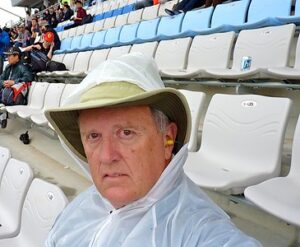
Here I was wearing my rainproof “Tilley” hat, a $5.00 Hefty garbage bag type poncho and shorts. At least I stood out. I also had my left arm extended toward the sky with the index finger of my left hand pointed toward the sky. I looked a little bit like the Statue of Liberty!
What you doing?
In hindsight, I’m thinking these fans didn’t know what my “one-finger” salute meant. About every five minutes a Korean would walk up to me and say in broken English, “What you doing?” When I told them I was looking for a ticket to buy, they smiled and walked on.
This reaction is not all that different from my buying tickets in this manner back home. Often a middle-aged lady will look at me and then say something to the effect to her husband, “Look at that poor guy. He doesn’t have a ticket. He’s out here begging for a ticket. He probably can’t afford to come to the game. The poor guy. I feel sorry for him”.
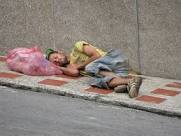
Folks, the next time you drive past a homeless person with a sign that includes any combination of the words, “Homeless, hungry, vet, disabled, need food or will work for food” please don’t feel sorry for them. They may very well be running a scam……er, a project that nets them more money than you make.
I am a professional; do not try this at home.
Those of you who are long-term readers of the RLR – Randy Lewis Racing reports know that these situations normally work out well for me. That’s why I smiled to myself when my bus mates were questioning this morning’s ticket-buying strategy. We would see what we would see. Even though I operate on a budget, I am a professional at this.
The first people to come up to me were two Korean policemen. Somehow THEY seemed to understand what I was up too. I could just see myself being carted off to a solitary Korean prison and being sentenced to be “caned”. That would be great. It would make a wonderful story. Soon the cops moved along.
I did have one Korean man attempt to sell me a ticket, but it wasn’t in the main grandstand. A young British woman came by to help me translate. She was a direct person. She offered several side comments like, “They aren’t selling any hot food in there. They built this place and it’s not ready. The place is shit”. Although I didn’t share her attitude I valued her translation skills.
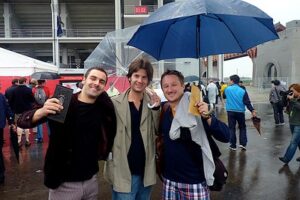
Finally, three white guys came bouncing past. Why use the “white” descriptor? Because these were white guys. One of them, from Canada, asked me how the pricing situation was going. He didn’t seem like an interested buyer OR seller. I get these guys often. They are somewhat like the middle-aged lady I told you about. They already have a ticket and don’t have any tickets to sell. They just like to “pull your chain”.
It pays to be nice to everyone.
However, I was taught in sales to be nice to everybody. You never know when the “odd person” will be in a position to help you. A bit later in my bid to get a ticket, I was hanging out near the “ticket box”. That’s when I ran into the “three white amigos” again. One was from New Jersey, the other from the U.K. and the guy I had met from Canada. They were trying to mix and match their tickets so they could all sit in the gold section. They had just completed a “switcheroo” that netted them an extra silver ticket. The Canadian guy told me they paid $200 U.S. for it. He asked me if I wanted the ticket for what they had paid, $200 U.S.
I had the sense that he might have paid even less, although when I asked him if he truly had paid $200 he said that he did. It didn’t really matter to me WHAT he had paid. He was offering me the ticket for $600 U.S. LESS than what the track was selling a silver ticket for. I grabbed it. We all entered the track together before I paid. That way I was assured the ticket was genuine. Remember, I AM a professional at this. This also eliminates the police seeing money exchanged outside the entry gate, a sure tip-off that tickets are being bought and sold. Don’t miss the pictures of my new “friends”. As a matter of fact, my slide show includes 199 photos that, after viewing, will make you feel as if you actually went to the Korean Formula One race.

Derrick thought I had done well.
After the race when I had returned to the bus I was talking to Derrick Smith, tour organizer extraordinaire. He asked me how much I had paid for my ticket. I told him “200 dollars”. He looked at me, rolled his eyes to the back of his head and said, “Oh!”. I had a momentary feeling of panic. Was Derrick’s reaction saying, “You poor American. They took you to the cleaners”. Truth be told I had never paid as much as $200 for a race ticket in my life. I can’t even recall (although my memory gets worse every year) paying over $100 for a ticket to any of my previous 1,604 tracks.
Derrick then said, “I paid $700 U.S. for my ticket”. The girl across the aisle who was from Virginia and teaching in Korea chimed in, “I paid 945,000 won for my three-day silver ticket (about $1,045 U.S.)”. Wow! They must be paying Korean English teachers a lot of money.
Now people looked at me with newfound respect. Maybe this crazy American wasn’t crazy after all. Derrick said, “My friend, I’ve learned something from you. I’m going to try that the next time I come here”. No problem I thought to myself. I’m casting pearls my reader’s way all the time. They just have to be smart enough to bend over and pick them up.
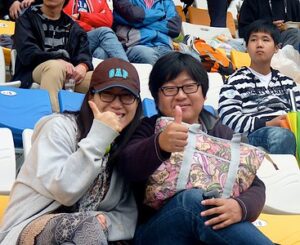
It was time to explore.
It was now 11 a.m. I was inside the entry point with four hours on my hands before the Formula One race would begin. The grandstand was state of the art. It was similar to those gleaming race palaces in Dubai and Qatar. Of course, “gleaming palaces” can only be built with government money!
First, I wanted to check out the souvenirs. My preference was to buy a shirt. However, I’ve found that most South Korean people aren’t as big as Americans. That’s mainly because Americans are about the fattest populace I ever see. The largest size was too small for me. The t-shirts were priced at about $33 U.S. Luckily, Derrick had provided a very nice looking “Korean F1” shirt to each of his travelers. You’ll see me wearing that all over in the near future.
Editor’s note #4. In point of fact, I never ever wore the t-shirt Derrick gave me. I keep it folded and draped over a globe in my office. The shirt and the globe remind me every day that I’m home of this amazing adventure.
I did settle on a nice-looking “Korean – Formula 1” black hat. The price was about $28 U.S. I’ll wear that on my next round of golf. The souvenir situation was taken care of. Now I was in pursuit of “track food”.
What about the food?
I’ve been to nearly 200 foreign tracks in what is now 48 countries. I’ve seen both “good” and “bad” food offerings. Jamaica, Guyana, Portugal, Guatemala and Colombia stand out as places where I’ve had really tasty and unusual foods at the track. Korea will NOT be added to that list.
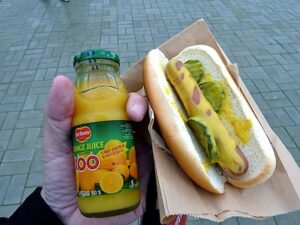
They had three just different food booths in the main grandstand area. One was selling poorly constructed hamburgers. Another sold hot dogs with PICKLES! Finally, one food stand was selling Teriyaki chicken and beef. There were a few local side dishes like carrots (I won’t even eat those at home) and thick noodles.
I settled on the Heineken and hamburger combo. These folks, like many foreign tracks, didn’t sell any diet soda at all. Later in the day, I would have a hot dog with mustard and PICKLES. To my knowledge, no hot dog vendor in my previous 1,604 tracks has ever offered pickles. There was one fresh fruit stand selling pineapples and melons. However, I don’t come to racetracks to eat fresh fruit.
South Korea was in the books.
It was nearing noon and a preliminary race featuring Hyundais was on tap. This race was for ten laps or 25 minutes whichever came first. I was in the grandstand for this event just to make sure (I had an unusual feeling) that this track was going to be countable.

Following this race, there was a colorful parade of dancers and musicians. It wasn’t the Rose Bowl parade by any means but I found it fun and entertaining. Don’t miss the pictures.
Who is Hans Stuck?
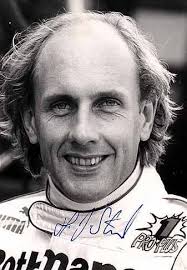
Now it was Formula One time! Folks, I have a disclaimer or two…..or three. I did not grow up with Formula One. I couldn’t tell you if Hans Stuck came from Iceland or India or outer space. By the way, I don’t understand the sport of soccer either. I am smart enough to understand this. LOTS of people LOVE Formula One. I can’t recall ever meeting a European who DIDN’T love Formula One. What does that mean to me? It means I’m probably missing something….but I don’t know what that something is.
I certainly do not understand the ticket pricing of Formula One. NASCAR is hugely popular and their average ticket price is around $75 U.S. I normally buy those tickets in prime locations for $20-40 U.S. each.
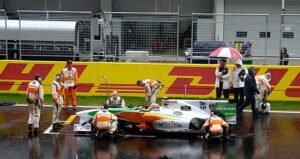
I certainly DO NOT understand the appeal of road course or “circuit” racing. I timed a lap today with my iPhone. The lap time came in at one minute and 52 seconds. Then I timed a car when it came into my view on this 5.62-kilometer (3.49 miles) course and when it left my sight position. I could see the cars flash by me for 9.8 seconds. A full lap took 112 seconds and I could see the racecars for less than ten seconds. What’s up with that? Should I watch my next football game with blinders on? I’ll just watch the action from the 20-yard line to the 30-yard line on one end of the field. No, I do not understand this circuit racing idea AT ALL.
However, this is a lot like going out with a friend. He may like bowling and you don’t understand the point. But in order to spend time with your friend, you go bowling. That’s how I approach circuit racing whether it’s Formula One in a foreign country or an SCCA race in the United States. At least I knew enough to understand I was seeing a race being viewed by millions all over the world today.
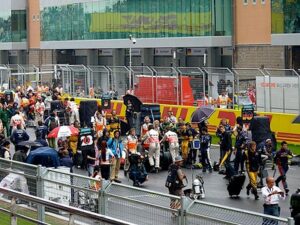
The pre-race activity was quite a scene.
Today’s race started with all the cars pulling onto the starting grid. I’ve never seen so many support people around the cars and on the track in my life. Each car had to have 15 team members on the track. They had electric tire warmers and a crew member standing next to each of the car’s four tires at the ready. The crew members don’t wear helmets, that I could see, and most were not in radio contact with the team manager. Each team even had some kind of a dry ice machine.
My silver seat grandstand ticket called for me to sit in the first row. This was not a Garth Brooks concert. Sitting in the first row was not a good thing. However, I took my ticket’s seat location as a “recommendation”. I always do that. The first four rows of the grandstand were getting wet from the rain. I took that as a “signal from heaven” to grab a seat a few rows up. It was the right thing to do.
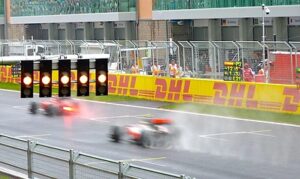
Formula 1 races in the rain right?
One of the things I most like about foreign-based racing is that they rarely rainout. In all of my non-U.S./Canada racing, I can only recall one race (I think it was in Belgium or somewhere in central Europe) that canceled because of rain. In that case, they canceled because of rain received a day or two in advance.
I don’t watch Formula One on TV. The races come on live in the U.S. at about 4 a.m. I could record the programs but the few times I’ve watched a little bit of these races I was bored stiff because there is little or no passing. Europeans call “passing” “overtaking”. There isn’t much “overtaking” either. I did wish I had thought to record the Korean Formula One race from today though. If I came home and watched it on TV at least I might know what happened.
The announcing was in both Korean and English. That was a good thing. The 3 p.m. start was delayed by ten minutes. The delay was for the rain that was falling lightly but steadily. The race distance was 55 laps or two hours whichever came first.
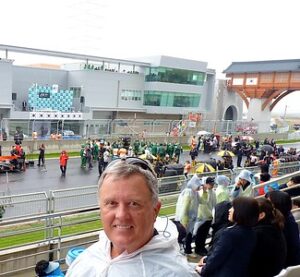
I suspect the “two-hour” time limit is a TV thing. NASCAR racers average about four hours in length. Some think that’s too long. They may be right. However, if the races were shortened people might not think they were getting their money’s worth. I doubt that even if I understood what Formula One was all about I would think I got my money’s worth at $700-800 for two hours of entertainment. I can’t think of ANY entertainment that is worth that kind of money to me.
Much of this race was run under the yellow flag.
They did start the race at 3:10 p.m. However, they started the race “under caution”. The laps were counting but the starting grid of cars followed the Mercedes-Benz pace car around the track at high speeds. In situations like this, no one is allowed to pass another competitor. I guess that’s not much different from when they are actually racing!
The most impressive thing I saw on the track all day was the Mercedes-Benz pace car driver. He had to be driving that car well over 100 M.P.H. down the front straight in a steady rain. The car raised a huge “rooster-tail” of water as did the Formula One racers.
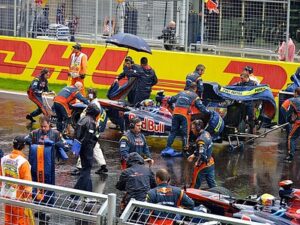
Folks, this was a 55-lap race. They ran the first 17-18 laps under caution. Then….they showed the red flag and everyone came in and stopped on the grid. What was up with this? I thought Formula One raced in the rain.

Although it was not raining heavily, the track was creating problems. It seemed with the newly poured “tarmac” the surface did not drain well. This created huge plumes of water spray that the Formula One officials deemed to be unsafe for racing. The race had been scheduled to begin at 3 p.m. It would be dark by 6 p.m. The track had no lights. They started late and then stopped the race before any cars ever took a green flag. You can do the math.
I couldn’t believe they almost rained out.
Little did I know but this race came close to being canceled! Are you kidding me? I had just paid more to see this race than any other…..ever. If NASCAR canceled a race, they run on the “next clear day”. I was prepared to stay in Korea another day if needed. Apparently, a similar situation occurred in Malaysia two years ago with Formula 1. They didn’t reschedule the race but simply rewarded “half-points” to the drivers. What about the fans? Did they refund the ticket prices in Malaysia? I doubt it. However, if they did I could return my ticket purchased for $200 for the face value price of more than $700. Yes, I am always thinking.
Fortunately, the rain let up and the race was able to restart. The announcer told us they would race until 5:57 p.m. or for the originally scheduled 55 laps, whichever came first. I did a quick calculation with my iPhone calculator and figured they would have a hard time completing the full 55 laps.
Let me explain what all of this meant from a “trackchasing perspective”. First, this track and country became “countable” when I saw the Hyundai race that began at noon. Even if I had not seen that preliminary race this track it became “countable” when the F1 race was officially started under the yellow flag. Therefore, I didn’t have that churning stomach feeling I sometimes get in the U.S. when weather threatens to cancel a race when the cars are ready to go.
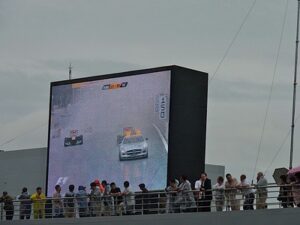
There may have been some “overtaking” today. However, if there was I didn’t see it personally. I did see some passing on the big video screen situated near me. I also saw several cars slide off the track due to the wet racing surface. This would have been a better event to watch on TV. However, the people who run trackchasing wouldn’t let me count South Korea unless I flew more than 15,000 miles round-trip and sat out in the rain. I’m not complainin’ just explainin’.
They finished right at dark.
As darkness set in the checkered flag was displayed. The Red Bull driver, Mark Webber, crashed while leading on the second green flag lap (lap 19). Ultimately, Ferrari driver Fernando Alonso would win the race that took two hours and 48 minutes. At the time I didn’t know who had crashed and who won the race.
Please don’t be offended.
I don’t want my Formula One friends to be offended by any of my comments about F1. I have vowed to begin watching these races on U.S. TV. That way the next time I attend an F1 race, I will be better informed.
Editor’s note #5. In point of fact, I have never started to watch F1 racing to this day.
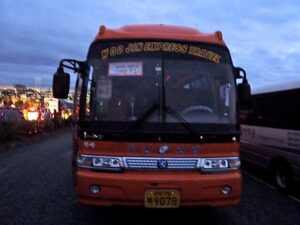
I had the time of my life….I always do.
From there I scurried back in the dark to try to find our bus. Don’t get me wrong. I had the time of my life today. I didn’t get arrested for buying scalped tickets. I had a great seat at what other people told me was a low purchase price. I studied the people and took photos and videos from every conceivable angle. Despite my not having a real clue about what Formula 1 is all about I had a wonderful time.
As mentioned, today’s race was supposed to begin at 3 p.m. It was scheduled to run 55 laps or two hours, whichever came first. Derrick had directed everyone to “be on the bus” by 5:30 p.m. However, with the rain delays that schedule had to be moved back, didn’t it?
The race didn’t finish up until almost 6 p.m. By the time I got out into the bus parking lot it was dark. There were lots of buses to choose from. I was only hoping that our departure time of 5:30 p.m. had been adjusted to account for the race’s late start. I could just imagine the bus had already departed with my computer attached to a bus seat by my cable security lock.
Alas, the bus had not left. I was actually one of the first people back to the bus. We would not leave until 7 p.m. All but three of the buses were headed to Gumi City, South Korea. Two other folks and myself needed to get back to Gwangju where we would stay the night again before heading our separate ways on Monday.

If you go to the Korean F1 race do it with Waegook Cook Travel.
It was going to be an inconvenience for the rest of the passengers but Derrick insisted on taking us back to Gwangju, an hour out of the way. That was just one of the many ways that Derrick looked out for my welfare. I had forgotten what fun it could be to take a bus ride with folks. In the short time we had all met, friendships were already being made. Derrick was a master host. He had nearly 100 people to work with riding on two buses. Most of them (including me) were asking him non-stop questions. Yes, he was busier than a “one-legged man in an ass-kicking contest”. Nevertheless, he made sure he took the time to meet every quest’s needs. He was fantastic as the “big picture” guy. On the other hand, his Korean-born wife, Sugi, was scurrying around attending to the “small picture” details. They made a fantastic couple.
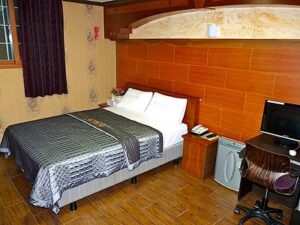
We arrived back at our hotel at 9 p.m. I had left my luggage and personal effects in room 602 of the Lawrence Hotel where I had expected to return tonight. However, for unknown reasons to me, I would be staying in the Ritz Motel (not to be confused with the Ritz-Carlton Hotel) tonight. The hotels were within 15 feet of each other. I just hoped, as Derrick had promised, that my “stuff” would be “transferred” from my old room to the new one. Fortunately, it was!
No Korean pizza for me.
The tour bus had called ahead for pizza. However, they would eat that on the bus after they dropped the three of us in Gwangju. That was too bad. I wanted to experience the taste of Korean pizza.
Before he departed Derrick insisted on introducing me to an “Australian race driver” friend of his. Derrick was most impressed with my “celebrity status” as a globetrotting trackchaser and introduced me to everyone in that manner. What was about to transpire next was definitely one of the weirder late-night evenings I’ve had in a long time.
I was soon to be introduced to “Matthew”, an Australian GT3 driver living in Japan. He was traveling with a sidekick. It was obvious these two Aussies had had a beer or two before we arrived at the hotel. Soon, the “group” of Matt and his friend as well as the three of us staying in Gwangju were headed off to dinner at 9:30 p.m.
This was going to be a most unusual dinner.
At that time of night, I would have normally “begged off” from dinner. However, I was intrigued at the opportunity to have dinner with four people from places a long way from where I come from. Additionally, we would be eating “Korean BBQ” where the stove is in the middle of the table. Diners cook their own raw food. What was about to happen next made for an interesting three hours.

Of course, when we entered the restaurant it is a Korean custom to remove one’s shoes. This was actually a good idea. It allowed my socks to dry out!
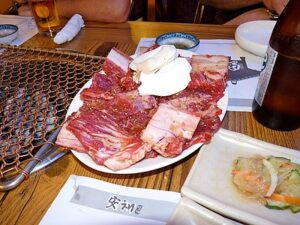
Once seated, there was ZERO English spoken by our server and no mention of English on the menu. There were pictures of raw meats but that was it. The first few selections were what I would charitably call “questionable”. Even my fellow dining companions shared that opinion.
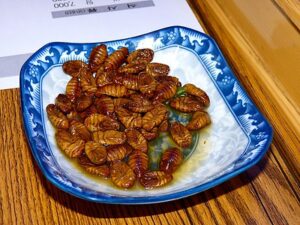
Nevertheless, we cooked stuff “medium-well” and chewed extra hard. I have absolutely no interest in knowing what we ate! The meats were served with a multitude of side dishes. One of which was “grub worms”. Matthew wanted me to sample these. However, after he described this as chewing on his “grandmothers two-week old socks” it solidified my opinion (not that it needed to be) to pass. Don’t miss the pictures.
And the beer flowed….and it flowed some more.
Everyone else was drinking (and had been drinking) lots of beer. Late in the evening, they would switch to some “white lightning”. I drank only Coco-Cola. I wanted to have a decent day of traveling tomorrow. As the evening wore on my friends felt “better and better”. It’s somewhat amazing how funny people think their stories are when they’ve been drinking!
I felt as if I knew ‘Uncle Vern’.
Matt dominated the conversation with stories of his chain-smoking Uncle Vern (God rest his soul) and many others. Matt was both aggressive and direct if nothing else. The “F-bomb” was dropped more than frequently. He took our elderly server by the hand on more than one occasion and tried to get her to serve us different foods. She didn’t speak a word of English and he didn’t speak Korean. Frankly, at times it was a bit uncomfortable.
Matt also wanted to “know about me”. Normally, I appreciate anyone’s interest. However, his approach seemed to me to be more of “impress me with something in your background so I will like and/or respect you”. Yes, there was a good deal of “judging” going on.
I told him a bit about where I had grown up, my education and past business career. This almost seemed to irritate him. He was into that “anti-corporate” thing and seemed to think anyone who went that route had “sold-out”. He was also put off some by my being an American.
It seems that Matt lives with his Japanese-born wife in Okinawa, Japan. He feels the “50,000 Marines” that are stationed there are “occupiers” of the country. I’m a former Marine. Matt and I just were not hitting it off.
I have many “conservative” friends who read these reports. Folks, there are a LOT of people across the world who don’t like Americans. They see us as “bullies” and “occupiers”. Sue, the United Kingdom native, now living in Malaysia chimed in with “If it weren’t for the Americans we would all be speaking German right now”.
Mean spiritedness is never a good thing.
To say the least it was a lively and sometimes mean-spirited (it seemed to me) event. Even Matt’s more laid-back sidekick questioned America’s involvement in places like Vietnam and Iraq. Of course, it is the government of these countries that decide policy and not its residents. Sometimes people forget this.
Toward the end of the evening, I did seem to score some points with Matt and his friend. How did I do that? I told them I sometimes slept in my car on trackchasing trips!! That seemed to resonate with them. It made me an “everyman”.

Bill Clinton?
Often times during the discussion I gave them my feedback on their personal or political questions. This came in the form of “Here’s one way to think about it. For these reasons the subject could be thought about in this manner and on the other hand, the subject could be thought about in the opposite manner”. This elicited a response that I should have been a politician! They all agreed I might be better off running for senator than spending my time trackchasing. The sidekick even mentioned that I looked and reminded him of Bill Clinton. Frankly, I get that a lot. Just last week the LAX bus driver mentioned, “You look a lot like Bill Clinton”.
At midnight I mentioned to the group, as they ordered more to drink, that I had a long travel day ahead of me and needed to get going. They smiled and kept talking. As the clock approached 1 a.m. (I had no idea what time the restaurant would be closing) I insisted I had to leave. By now they knew I was serious.
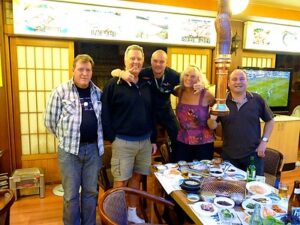
Then we all “hugged it” out.
At this point, I seemed to have won Matt over as being a “good man”. He even said that in a previous life we might have been fellow sailors on an Australian freighter. Yes, there had been a lot of drinking! At that point, there were multiple hugs and handshakes from Matt and others. It was a strange night that at times bordered on the dangerous and finished up with everyone “hugging it out”. Even with the last hug I still was convinced he wasn’t going to slug me!
If after reading hundreds of these reports you get only one thing out of these writings, it’s that I’m in this for the adventure. Please don’t think I do it because I’m a “race nut”. Yes, I enjoy auto racing. However, it’s the “adventure baby”. Don’t miss the photos of our unusual dinner group.
Day 4 – Monday

It was time to head for the barn.
This had to be one of my more unusual “out Friday back Monday” trackchasing trips. I was only on the ground in Korea for about 48 hours. Some might ask “Why go to South Korea for such a short time?” My answer is simple. “Why not? Spending 48 hours in a place like this is 1,000% better than spending NO time in a place like this”.
Editor’s note #6. I would return to South Korea another time or two with Carol. No, we never had the “thrill rides” this trip produced but we still had fun.
Today’s travel plan was both simple and straightforward. I wanted to go from Gwangju, South Korea to San Clemente, California. I woke up at 7:30 a.m. Korean time on Monday. For the timekeepers in the audience that would be 3:30 p.m. on SUNDAY in sunny San Clemente. Yes, it would be accurate to say that I left “yesterday”.
If all went well I would be home by about 4:30 p.m. on Monday. I would be arriving home just nine hours after I left Korea time zone wise. Of course, I would have traveled for 25 hours straight. On the other hand, if things did NOT go well…………we’ll cross that bridge if and when we come to it.
My hotel was about a two-block walk from the bus station. It would have been good to know that before I hailed a cab in heavy traffic upon my arrival on Saturday night. However, despite my taxi driver getting lost during that short drive the fare was only $4.00 U.S.
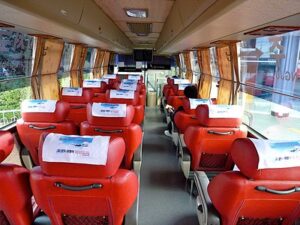
I had no idea when the next bus was leaving for the Incheon International Airport. The bus ride would take about five hours. I was thinking the buses left every 30 minutes or so. They did. I paid the same fare, 30,900 won (about $35 U.S.) for the ride as I did coming down here. That seems awfully inexpensive considering the trip would be aboard a modern tour bus with just six other passengers riding on a bus that had a 28-person capacity. I used my “riding time” to alternately gaze out the window at the passing countryside and play with my computer.
Editor’s note: By “play with my computer” I mean create my Trackchaser Reports work with my photos and videos for your future viewing enjoyment. I absolutely love doing this. If I didn’t, I wouldn’t do it.
I was getting better at this.
It’s amazing how valuable a “learning curve” is. When we made our “pit stop” at a highway rest area coming down everything seemed a bit confusing. However, this morning when we stopped for 15 minutes it all seemed very normal. That’s one of the best things about international travel. The more you do it the more comfortable you get in some pretty strange situations at times.
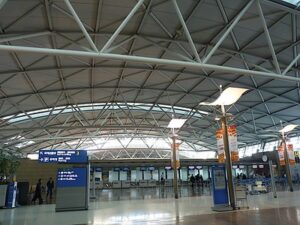
The Incheon International Airport in Seoul is gorgeous. You can tell where the world’s money is flowing. The airports in Bangkok, Hong Kong, Tokyo as well as Seoul are state of the art fantastic places. They are all brand new or nearly so with all kinds of shopping and other services. Contrast that with the generally older and smaller airports on the other continents I visit and you can see which countries are “doing well”.
Editor’s note #7. The Incheon International Airport in Seoul is still my favorite international airport. I’ve slept overnight there. I have explored every inch of the place including the arboretum.
With the long bus ride, I still had nearly four hours to wait for my flight to San Francisco. If I made that flight I might be able to grab another airplane down to Orange County and be home in time for dinner.

Technology makes the world a lot smaller.
I used my TruPhone app to call Carol for the first time this weekend. With TruPhone the number rings as quickly as if you were calling from across the street. The voice quality is excellent and there is no “lag”. This costs just pennies a minute. All you need to use these VOIP calls is an internet connection. The biggest challenge with making the call was finding a convenient time to talk given the 16-hour time difference.
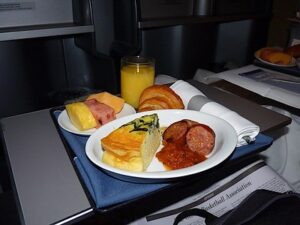
I was upgraded to business class for the 10-hour ride back to California. On such a long flight business class really helps. The planes I use have just recently upgraded to 180-degree lay-flat seats in business class. This allowed me to catch a few hours of “real” sleep on the plane. I did take a few minutes to watch the Joan Rivers documentary about her career. At 75 she pushes harder than she ever has to “keep it going”. I’m not sure that’s a good idea but to each his own.
SUMMARY
There were lots of places where this plan could have collapsed.
This trip had the opportunity to go south (I don’t mean South Korea) at a number of points. As it turned out EVERYTHING worked perfectly. My transportation plans went exactly as planned. Lodging was very good considering the options. I didn’t really have the opportunity to eat as much local food as I would have liked because much of this trip was “on the run”.
It’s always the people who make the trip.
However, the real highlight was the people. You will rarely hear me say the “real” highlight was the racing. You will normally see me writing that it was the great people that made the trip worth the effort. That was certainly true with Derrick Smith and his clan including Sugi his wife. O.K., Matt was a dick.
At EVERY turn they went out of their way to help me and make sure my trip was comfortable. Considering I hadn’t really even “signed up” for the trip this was remarkable. If you ever want to go to the Korean Formula One race you need to do it with Derrick and his travel group at Waegook Cook travel. By the way, “Waegook Cook” means “foreign chef” in Korean.
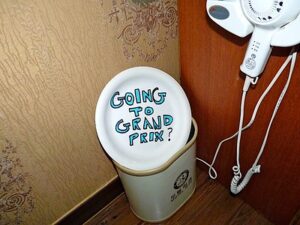
Sometimes I wonder how I come in contact with so many great people on these international trips. Normally the contacts come from the internet in one form or the other. I’ll start talking to people and before long a relationship comes about. I am blown away at how much people will “care” about helping me make my trip a success.
Thanks for reading about my trackchasing,
Randy Lewis
World’s #1 Trackchaser
South Korean saying: Words have no wings but they can fly many thousands of miles.
This is my video showing the highlights of the trip including the first-ever World F1 race from South Korea
This video courtesy of Derrick Smith, our tour organizer
RLR – Randy Lewis Racing Lifetime Trackchasing Countries
# 1 – UNITED STATES OF AMERICA – Peoria Speedway (Mt. Hawley, oval) – Track #1, Peoria, Illinois – circa 1954 (age 5)
# 2 – CANADA – Cayuga Speedway (oval) – Track #174, Nelles Corner, Ontario, Canada – July 31, 1988 (Dick Trickle winner)
# 3 – AUSTRALIA – Parramatta City Raceway (oval) – Track #180, Granville, New South Wales, Australia – November 17, 1989 (accompanied by Carol)
# 4 – UNITED KINGDOM – Northhampton International Raceway (oval) – Track #378, Northhampton – June 26, 1999 (accompanied by Carol, Kristy, Jim)
# 5 – NETHERLANDS – Driesum Racetrack (oval) – Track #839, Driesum – May 5, 2005 (accompanied by Roland Vanden Eynde)
# 6 – BELGIUM – Bellekouter oval (oval) – Track #841, Affligem – May 8, 2005 (accompanied by Roland Vanden Eynde)
# 7 – FRANCE – Circuit de Croix en Ternois (road course) – Track #843, Saint-Pol sur-Ternoise – May 8, 2005 (accompanied by Roland Vanden Eynde – 2nd new country in one day!)
# 8 – GERMANY – Nurburgring (road course) – Track #844, Nurburg – May 13, 2005 (accompanied by Carol, Roland Vanden Eynde)
# 9 – NEW ZEALAND – Western Springs Speedway (oval) – Track #1,134, Western Springs – December 26, 2006 (accompanied by Carol)
# 10 – MEXICO – Triovalo Bernardo Obregon (oval) – Track #1,281, Tiajamulco de Zuniga, Jalisco – October 14, 2007 (accompanied by Carol, J.J., Roger Ward)
# 11 – BARBADOS – Bushy Park Racing Circuit (road course) – Track #1,296, Bushy Park – December 9, 2007
# 12 – THAILAND – Bira Circuit (road course) – Track #1,300, Pattaya – January 19, 2008
# 13 – SOUTH AFRICA – Durban Grand Prix (road course) – Track #1,315, Durban, KwaZulu-Natal – February 24, 2008 (accompanied by J.J. and Will Van Horne)
# 14 – JAMAICA – Dover Raceway (road course) – Track #1,322, Brown’s Town St. Ann – March 24, 2008
# 15 – SWEDEN – Sturup Raceway (road course) – Track #1,335, Malmo – May 10, 2008 (accompanied by Carol)
# 16 – DENMARK – Ring Djursland (road course) – Track #1,336, Tirstrup – May 11, 2008 (accompanied by Carol)
# 17 – CZECH REPUBLIC – Automotodrome BRNO (road course) – Track #1,381, Brno – September 13, 2008
# 18 – AUSTRIA – Lambrechten Stock Car Track (road course) – Track #1,382, Lambrechten – September 14, 2008
# 19 – IRELAND – Tipperary International Raceway (oval) – Track #1,388, Rosegreen – October 26, 2008 (Carol and I visited this track earlier in the year)
# 20 – GUYANA – South Dakota Circuit (road course) – Track #1,390, Timehri – November 2, 2008 (accompanied by Carol)
# 21 – CHINA – The Guia Circuit (road course) – Track #1,392, Macau – November 16, 2008 (accompanied by Carol)
# 22 – COSTA RICA – Autodromo La Guacima (road course) – Track #1,398, La Guacima – November 30, 2008
# 23 – ANDORRA – Grandvalira Circuit (road course) – Track #1,404, Port d’Envalira, Andorra – January 17, 2009
# 24 – ARGENTINA – Circuito Efren Chemolli (oval) – Track #1,406, Buenos Aires, Argentina – January 31, 2009 (shared with Jerry Fisher)
# 25 – QATAR – Losail International Circuit (road course) – Track #1,408, Doha, Qatar – February 13, 2009
# 26 – BAHRAIN – Bahrain International Circuit (road course) – Track #1,410, Sakhir, Bahrain – February 27, 2009 (accompanied by Carol)
# 27 – UNITED ARAB EMIRATES – Dubai Autodrome (road course) – Track #1,411, Dubai, United Arab Emirates – February 28, 2009 (accompanied by Carol)
# 28 – COLOMBIA – Autodromo de Tocancipa (road course) – Track #1,415, Tocancipa, Colombia – March 22, 2009
# 29 – SPAIN – Motorland Aragon (road course) – Track #1,416, Alcaniz, Spain – March 28, 2009
# 30 – PORTUGAL – Circuto de Murca (road course) – Track #1,417, Murca, Portugal – March 29, 2009
# 31 – ICELAND – Kapelluhraum (road course) – Track #1,420, Hafnafjorour, Iceland – April 25, 2009 (shared with Will White)
# 32 – HUNGARY – Hungaroring (road course) – Track #1,426, Mogyorod, Hungary – May 8, 2009 (accompanied by Carol)
# 33 – SWITZERLAND – Hock Ybrig (road course) – Track #1,427, Hoch Ybrig, Switzerland – May 9, 2009 (accompanied by Carol)
# 34 – ITALY – Vighizzolo d’Este Stock Car Track (road course) – Track #1,428, Vighizzolo d’Este, Italy – May 10, 2009 (accompanied by Carol)
# 35 – DOMINICAN REPUBLIC – Autodromo Mobil 1 (road course) – Track #1,515, Santo Domingo, Dominican Republic – December 6, 2009 (accompanied by Carol)
# 36 – MALTA – Ta’Qali Race Track (road course) – Track #1,521, Ta’Qali, Malta – February 7, 2010 (accompanied by Carol)
# 37 – FINLAND – Lake Pidisjarvi Ice Track (road course) – Track #1,524, Nivala, Finland – February 20, 2010
# 38 – JAPAN – Suzuka Circuit (road course) – Track #1,530, Suzuka, Japan – March 21, 2010
# 39 – CHILE – Autodromo de Interlomas (road course) – Track #1,531, Temuco, Chile – April 18, 2010
# 40 – MOROCCO – Circuit de Marrakesh (road course) – Track #1,535, Marrakesh, Morocco – May 1, 2010 (accompanied by Carol)
# 41 – BRAZIL – Circuit de Caruaru – Aryton Senna (road course) – Track #1,540, Caruaru, Brazil – May 16, 2010 (accompanied by Carol, Jerry Fisher and Katia Maria Spencer)
# 42 – ESTONIA – Laitse Rally Park (road course) – Track #1,571, Laitse, Estonia – July 24, 2010 (accompanied by Carol)
# 43 – LATVIA – Bikernieki (road course) – Track #1,572, Riga, Latvia – July 25, 2010 (accompanied by Carol)
# 44 – GUATEMALA – Autodromo Pedro Cofino (road course) – Track #1,580, Alotenango, Guatemala – August 15, 2010
# 45 – EL SALVADOR – El Jabali (road course) – Track #1,582, Quezaltepeque, El Salvador – August 22, 2010 (accompanied by Carol)
# 46 – ROMANIA – Bradu (road course) – Track #1,603, Bradu, Romania, El Salvador – October 16, 2010
# 47 – BULGARIA – Closed Route – Burgas (road course) – Track #1,604, Burgas, Bulgaria – October 17, 2010 (accompanied by Lyubomir and Plamen Simeonov)
# 48 – SOUTH KOREA – Korea International Circuit (road course) – Track #1,605, Yeongam, Jeollanam-Do, South Korea – October 24, 2010
The ‘International Big 5’ standings.
During the last 37 months, I have added 39 trackchasing countries to my list. That’s an average of just over one new country every month for more than three years.
- 1. Randy Lewis, San Clemente, California USA – 48
- 2. Roland Vanden Eynde, Vilvoorde, Belgium – 46
- 3. Carol Lewis, San Clemente, California USA – 24
- 4. Will White, Quakertown, Pennsylvania USA – 23
- 5. Chris Economaki, Charlotte, North Carolina USA – 20
Will I continue trackchasing internationally? That all depends. What does it depend on? It’s simple. If my fellow competitors travel, then I will travel. If they don’t……I might still travel!
SOUTH KOREA – FAST FACTS*
SOUTH KOREA!
South Korea, officially the Republic of Korea and sometimes referred to simply as Korea is a country in East Asia, located on the southern portion of the Korean Peninsula. It is neighbored by the People’s Republic of China to the west, Japan to the east, and North Korea to the north. Its capital is Seoul and the country has a population of 50 million.
The war and the economy.
After liberation and occupation by the Soviet and U.S. forces at the end of World War II, the nation was divided into North and South Korea. The latter was established in 1948 as a democracy. After the invasion of South Korea by forces from the North on June 25, 1950, the resulting war between the two Koreas ended in an uneasy cease-fire, and the border between the two nations is currently the most heavily fortified in the world. After the war, the South Korean economy grew significantly and the country was transformed into a major economy, a full democracy, and a regional power in East Asia. The economy is export-drive, with production focusing on electronics, automobiles, ships, machinery, petrochemicals and robotics.
Climate.
South Korea tends to have a humid continental climate and a humid subtropical climate with precipitation heavier in the summer during a short rainy season called “jangma”, which begin from the end of June through the end of July. Winters can be extremely cold with the minimum temperature dropping to -20 degrees Centigrade. In Seoul, the average January temperature can range from 19-33 degrees Fahrenheit and the average August temperature ranges from 71 to 86 degrees Fahrenheit. Rainfall in Seoul averages 58 inches annually. There are occasional typhoons that bring high winds and floods.
Economy.
South Korea has a market economy that ranks 15th in the world with nominal GDP. South Korea is heavily dependent upon international trade. In 2009, they were the eighth largest importer and tenth largest exporter in the world. South Korea was one of the few developed countries that was able to avoid a recession during the global financial crisis. Its economic growth rate will reach 6.1% in 2010.
Transportation and energy.
South Korea has a technologically advanced transportation network consisting of high-speed railways, highways, bus routes, ferry services, and air routes that crisscross the country. Express bus terminals are available in most cities. Constructions of South Korea’s largest airport, Incheon International Airport, was finished in 2001.
South Korea is the world’s fifth-largest supplier of nuclear energy. South Korea is not allowed to enrich uranium on its own due to U.S. political pressure. The U.S. has recently been wary of South Korea’s burgeoning nuclear program, which South Korea insists will only be for civilian use.
Robotics.
Robotics has been included in the list of main national R&D project in Korea since 2003. In 2009, the government announced plans to built robot-themed parks in Incheon and Masan with a mix of public and private funding. In 2005, the country developed the world’s second walking humanoid robot, HUBO.
Plans for creating English-teaching robot assistants to compensate the shortage of teachers were announced in February 2010, with the robots being deployed to most preschools and kindergartens by 2013.
Education.
Education in South Korea is regarded as being crucial to one’s success, and competition is consequently very heated and fierce. In the 2006 results of the OECD Programme for International Student Assessment, South Korea came in first in problem-solving, third in mathematics and eleventh in science.
South Korea is the world’s first country to bring high-speed fiber-optic broadband internet access to every primary and secondary school nationwide. The country has developed the first digital textbooks in the world which will be distributed for free to every primary and secondary school in the nation by 2013. Most South Korea middle schools have school uniforms, modeled on western-style uniforms. Boy’s uniforms usually consist of grey trousers and white shirts, and girls wear grey skirts and white t-shirts.
Demographics.
South Korea is noted for its population density, which at 487 people per square kilometer is more than 10 times the global average. Following WWII, about four million people from North Korea crossed the border to South Korea. South Korea is ethnically one of the most homogeneous societies in the world with more than 99 per cent of inhabitants having Korean ethnicity. In addition, about 43,000 English teachers from the United States, Canada, Australia, New Zealand, the United Kingdom, Ireland and South Africa temporarily reside in Korea. South Korea’s birthrate is the world’s lowest.
Religion.
As of 2005, just under half of the South Korean population expressed no religious preference. Some 29.2% at that time was Christian (18.3% professed to being Protestants and 10.9% Catholics), and 22.8% were Buddhist. South Korea is also the second-largest missionary-sending nation.
Cuisine.
Korean cuisine is largely based on rice, noodles, tofu, vegetables, fish and meats. Traditional Korean meals are noted for the number of side dishes which accompany steam-cooked short-grain rice. Korean cuisine usually involves heavy seasoning, with sesame oil, soy sauce, salt, garlic, ginger and gochujang, a hot pepper taste.
Technology culture.
South Korean corporations Samsung and LG were ranked second and third largest mobile phone companies in the world in the first quarter of 2010. An estimated 90% of South Koreans own a mobile phone.
Sports.
The martial art taekwondo originated in Korea. This became an official Olympic sport in 200. Football (soccer) is the most popular spectator sport in Korea. Baseball is second most popular. Regular national football matches attract over 35% of whole TV viewers on average. During the 2002 FIFA World Cup, 83% of TV viewers watched the football match. In 1988, South Korea hosted the Summer Olympics in Seoul coming in fourth with 12 gold medals, 10 silver medals and 11 bronze medals. In October 2010 South Korea will host (I hope!) their first Formula One race to be staged at the Korean International Circuit in Yeongam, about 400 kilometers south of Seoul.
* Much of this info comes from my research at Wikipedia.
TRAVEL DETAILS
AIRPLANE
Orange County, CA (SNA) – San Francisco, CA (SFO) – 372 miles
San Francisco, CA (SFO) – Seoul, South Korea (ICN) – 5,620 miles
RENTAL CAR #1
No rental car but four buses!
Total bus mileage – about 610 miles
AIRPLANE
Seoul, South Korea (ICN) – San Francisco, CA (SFO) – 5,620 miles
San Francisco, CA (SFO) – Orange County, CA (SNA) – 372 miles
Total Air miles – 11,984 (4 flights)
Total Bus miles – 610 (4 buses)
Total miles traveled on this trip – 12,594 miles
TRACK ADMISSION PRICES:
Korea International Circuit – Yeongam, Jeollanam-Do, South Korea – $200
Total racetrack admissions for the trip – $200
COMPARISONS
LIFETIME TRACKCHASER COMPARISONS
There are no trackchasers currently within 200 tracks of my lifetime total.
1. Randy Lewis, San Clemente, California – 1,605
2. Ed Esser, Madison, Wisconsin – 1,342
3. Guy “The Kid” Smith, Effort, Pennsylvania – 1,321
Official end of the RLR – Randy Lewis Racing Trackchaser Report


